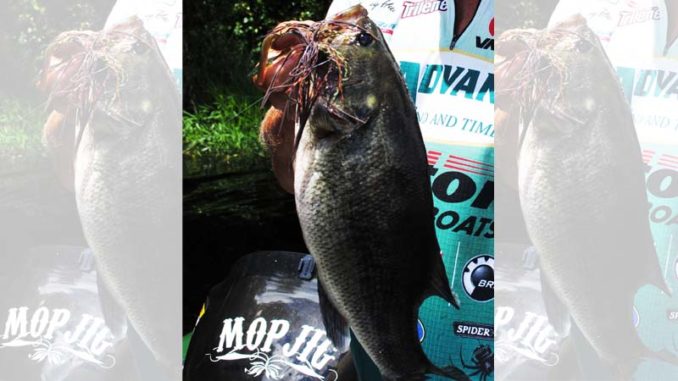
February: Big-bass time on Carolina lakes
I don’t make any bones about what and how I like to fish in February. I am going to tie on a big Mop Jig. Because February — and March — are the two best months in the Carolinas to catch a big bass. I think a big Mop Jig is the No. 1 bait, because with a soft-plastic trailer, it’s about the best way to imitate a crawfish that we have.
I really believe that crawfish is the preferred food of big bass in February. I have heard a lot of different ideas about why bass relate so much to crawfish in the early prespawn period. I’ve heard biologists talk about the high protein level in crawfish, and that’s probably true, because I think wildlife and fish can sense which foods are best for them — just like we can.
Crawfish are fairly active in cold weather. But I don’t think anything moves in February like it does in the warmer months. When I fish a jig, I’ll drag it across the bottom very slowly, and I’ll let it sit still. I’ve fished with a lot of different fishermen who were good jig fishermen, and I fish one a lot myself. I’m not the kind of person who can let a bait sit still for any length of time. But I do fish a jig that way in the winter. If you think about it, when you fish a jerkbait for early prespawn fish, you’re going to let it sit and suspend for a few seconds. With a jig, you’re doing the same thing; you’re just letting it sit on the bottom.
Jigs still have action even when sitting still
The good thing about a jig is, even though you’re not moving it, that living-rubber skirt still has some action in the water. The diameter of the rubber strands compared to silicon makes the difference.
I fish a jig all year, and when the water temperature is higher, I’ll hop it or swim it, but in February, I really slow it down. This time of year, I want to just crawl it along. I fish it with the rod tip so I can keep contact with it at all times. I guess I really fish it the way you drag a Carolina rig across the bottom — just slower.
Colors this month are fairly simple. The water is cold, and it’s typically stained, so I don’t want too much in the way of flashy colors because you really don’t see flashy colors in the water from crawfish or bluegill. I am going to make it very simple and just fish blacks and browns. I’ll change the colors of the soft-plastic trailer I fish — a Yamamoto PsychoDad — for some contrast: green pumpkin/blue, green pumpkin/chartreuse, black/red. They’ll give you a little something different, but they’re still basic colors.
Make long casts, fish slowly
I will go to a little bigger jig when the water is colder, where a lot of other people will go smaller. A slow fall is good, but a 3/8-ounce jig will be the smallest I’ll fish. I want that bait on the bottom. So I’m fishing a ½- or ¾-ounce Mop Jig most of the time. I want it resting on the bottom and moving very slowly.
I am going to be casting or making long pitches to rocks or other hard-bottom areas on the main lake. They can be sand or red-clay, but it’s the hard-bottom that’s important. You might be flipping in a place like Florida where you’ve got thick vegetation, but we don’t have that in the Carolinas, so I’m going to be making casts and longer pitches.
It’s really important to drag the bait and take your time, fishing it slowly. Again, slowing down is not something I usually emphasize. In fact, I think most people should be fishing faster most of the time, but not this month.
Pay attention; the bite will be subtle
It’s really, really important to pay attention to what you’re doing and what the jig is going. The biggest thing most people miss is that they don’t realize a fish has the bait in its mouth. In warmer water, a bass will really thump a jig, but in February, a lot of times all you feel is a little pressure, like the water feels heavy. I’ve said lots of times that a jig bite often feels like you’re dragging a jig through molasses, not water. A jig bite in the winter is a lot like the way a flounder sucks down a minnow and just sits there with it, not the thump you get when a speckled trout takes it.
Those are the basics. Even more basic is to get out on the water every chance you get this month. Days at the end of a little warm spell are always better because fish become more active, and we always have a few those days every February. The days are getting longer and the fish are starting to stir. When they get ready to feed up before the spawn, that’s when it’s time to catch a big jig bass.




Be the first to comment